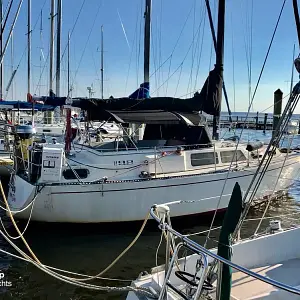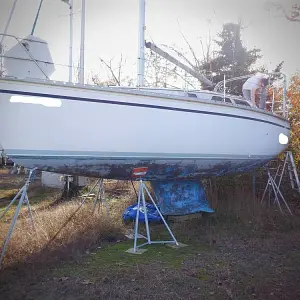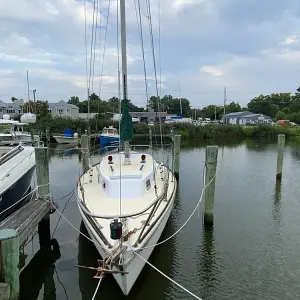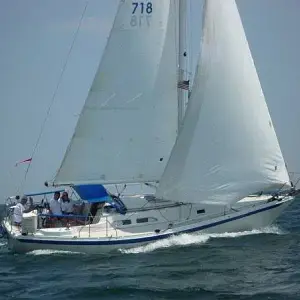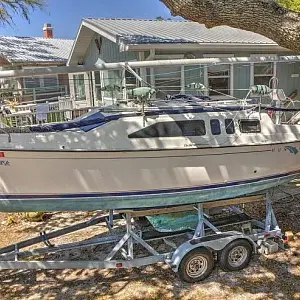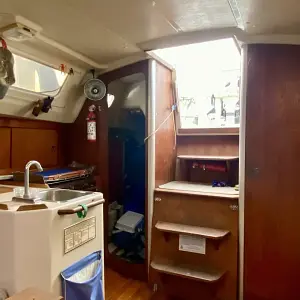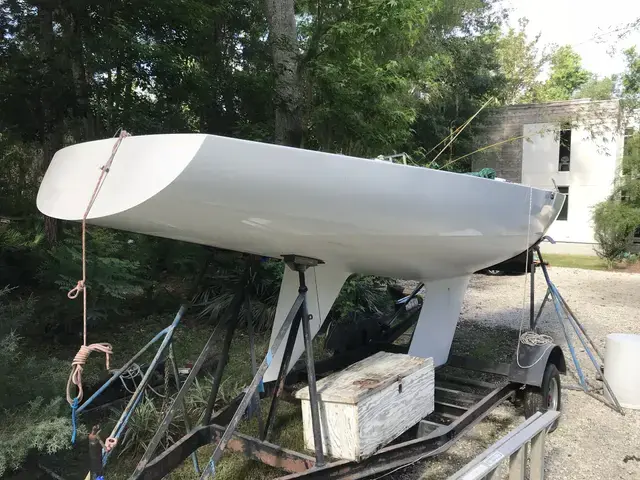If any one-design class has a cult following, it would be the Etchells. The boat was designed in the mid 1960s by Skip Etchells as a candidate to be the three-man Olympic keelboat. Despite dominance in the trials, the Etchells lost out to the Soling, but gained a dedicated group of sailors.
If any one-design class has a cult following, it would be the Etchells. The boat was designed in the mid 1960s by Skip Etchells as a candidate to be the three-man Olympic keelboat. Despite dominance in the trials, the Etchells lost out to the Soling, but gained a dedicated group of sailors. Since then, over 1200 hulls have been launched and sailed by individuals such as Dennis Conner who used the boat in training for his America’s Cup campaigns, Gary Jobson, Russell Coutts and Jud Smith.
SpecsFlag of Registry: United States
Keel: Other
Hull Shape: Displacement
DimensionsLOA: 30 ft 6 in
Beam: 7 ft 0 in
LWL: 22 ft 0 in
Maximum Draft: 4 ft 6 in
Displacement: 3325 lbs
Ballast: 2175 lbs
Bridge Clearance: 38 ft 4 in
EnginesEngine 1:
Engine Brand: None
Engine/Fuel Type: Other
The BoatLong and slender, the Etchells is one of the larger 3-4 man keelboats in recent history. A narrow waist at 6'11" and a 22' waterline belies an overall length of 30'6". The boat displaces 3,700lbs all up and draws 4'6". Described as "the boat they sail in heaven," the Etchells is very tunable and responds to the smallest adjustments.
Commonly dry sailed, the Etchells is easily trailered despite her length. Construction is fiberglass with an aluminum rig. The class association monitors the class carefully to ensure parity across the fleet from new hulls to old. This allows the boat to retain value better than most other classes.
Sail plan involves a main, jib and spinnaker (188 square feet, 103 square feet, 400 square feet respectively). A large main sail and relatively small jib create extremely tight tacking angles (around 70 degrees) for the boat. The short waterline length reduces wetted surface and allows for very quick light-wind sailing. In heavier air the Etchells goes upwind ?like a freight train?
Set-UpSet up is as simple as snapping jib hanks on, feeding main sail bolt rope into the track and casting off the lines. Of course, dry sailed boats may require a couple more steps before setting sail. A very good tuning guide can be found via Doyle Sails here (
Stay tension and position is used to control the mast bend and rake. Once adjusted, headstay, lower and upper shrouds should be tied off or locked to ensure they do not loosen while sailing. Backstay is the only stay tension adjusted on the water, using it to control the shape of the main to depower as necessary.
Similarly to the Lightning, mast chocks are used to further adjust rig shape while on the water. Mast chocks control mast pre-bend. Chocking behind the mast creates more pre-bend and vice versa. It is important to be checking headstay sag and jib shape while adjusting the chocks, as these settings are affected by mast bend.
In the Etchells, the jib drives the boat and encourages it to point unlike almost any other boat its size. In light winds, headstay sag should be adjusted by slacking the backstay and jib Cunningham to promote deeper draft and fuller sail shape. Higher wind conditions require more headstay tension (less sag) and jib Cunningham to draw the draft forward and flatten the sail. Jib sheets are trimmed through adjustable leads on cars; leads should be adjusted so that the telltales break evenly. Moving the car forward or back changes the sheeting angle and therefore the leach profile.
Main trim is a dynamic activity going upwind in an Etchells. The sail can be adjusted by a combination of the sheet and traveler. Just like on most boats with a mainsheet on a traveler, the sheet controls leach tension while traveler controls sheeting angle, not dissimilar to jib car position. In light air the traveler should be well up above centerline to allow the boom to be trimmed to centerline (or slightly above) while maintaining an open leach and flow. Ideally the top batten is parallel with the boom or slightly open. In heavier air the traveler car gets closer and closer to centerline with sheet tension increasing to increase leach tension. The backstay is trimmed in concert with the sheet/traveler as wind increases to flatten the sail.
The ClassAfter 48 years of existence, the Etchells class still draws a crowd. The 2014 Etchells World Championships in Newport, RI saw nearly 100 boats from around the world gather for some extremely competitive racing. Sailors such as current World Match Racing Circuit all star and former Boston College standout Taylor Canfield (USA 979, 2014 World Champions, Hardesty/Canfield/Roble/Eagan) went toe to toe with club sailors and weekend warriors through nine races over five days of racing out of the prestigious New York Yacht Club in conjunction with Sail Newport.
The North American Etchells Class website is very well organized, easy to follow and provides a plethora of resources for the emerging Etchells sailor ( Class rules, schedules for North American and International competition, tips and tricks, contact information for all the class officers and boat/crew classifieds are available on the site.
ConditionAfter casually sailing for several years this Etchells has been out of the water for the last 3 years. She was built by Ontario Yachts in 1983 Hull 585.
Some of the recent work and maintenance include:Bottom faired and 3 coats of Interlux barrier coatTop sides faired, primed and Awlgrip painted whiteNew Ipe keel boardNew tiller with 6 coats of varnishNew bilge pump hoseNew wheels and tires on trailerNew high tech jib halyard and main halyard
Other features:Kenyon mastExtendable carbon fiber bow sprit(for PHRF racing and removable for One Design)Asymetrical spinnaker for PHRF racingFull boat cover that needs a few repairsManual bilge pumpMast mounted compassOutboard bracket not installedSails in various conditions:5 mains6 jibs3 symmetrical spinnakers1 asymmetrical spinnaker
4250 Lakeside Drive
Suite 205
Jacksonvile, FL 33221 United States
Toll-freeTel
Email Us

